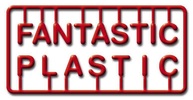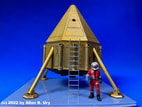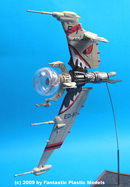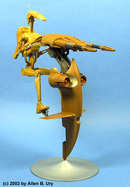Science Fiction - 1990s
In the Science Fiction arena, the "Digital Decade" started off like gangbusters as new sci-fi and fantasy kits appeared by the crate-load thanks to the ever-burgeoning number of genre programs gracing the airwaves. "Star Trek: The Next Generation" begat "Star Trek: Deep Space Nine," which begat "Star Trek Voyager," while J. Michael Straczysnki's "Babylon 5" simultaneously demonstrated the power and flexibility of low-cost CGI.
In Hollywood, the producers of "Independence Day" (1996) surprised everyone by handing the license for its spacecraft designs to the Lindberg Line, while the long-awaited "Star Wars" prequel, "Episode I - The Phantom Menace" (1999) contributed a half-dozen new members to the now-familiar Lucasfilm pantheon of X-Wings, TIE fighters and AT-AT's, courtesy of AMT/Ertl (the company also responsible for exploiting the new "Lost in Space" movie).
And then, just as the 20th Century prepared to enter the history books, the Science Fiction field imploded. Citing sagging sales, AMT/Ertl abruptly ceased production of all its "Star Trek" and "Star Wars"-related kits, then went out of the plastic model kit business altogether. Revell/Monogram, which had briefly held the license for UPN's "Star Trek: Voyager," saw its first half-dozen entries meet with only a tepid response, and so decided to get out of the sci-fi business as well.
Suddenly, what had been a gusher turned into a dry hole. For the first time in 50 years, only one company -- the upstart manufacturer Polar Lights -- was producing licensed Science Fiction models.
Was this the end of Fantastic Plastic modeling?
In Hollywood, the producers of "Independence Day" (1996) surprised everyone by handing the license for its spacecraft designs to the Lindberg Line, while the long-awaited "Star Wars" prequel, "Episode I - The Phantom Menace" (1999) contributed a half-dozen new members to the now-familiar Lucasfilm pantheon of X-Wings, TIE fighters and AT-AT's, courtesy of AMT/Ertl (the company also responsible for exploiting the new "Lost in Space" movie).
And then, just as the 20th Century prepared to enter the history books, the Science Fiction field imploded. Citing sagging sales, AMT/Ertl abruptly ceased production of all its "Star Trek" and "Star Wars"-related kits, then went out of the plastic model kit business altogether. Revell/Monogram, which had briefly held the license for UPN's "Star Trek: Voyager," saw its first half-dozen entries meet with only a tepid response, and so decided to get out of the sci-fi business as well.
Suddenly, what had been a gusher turned into a dry hole. For the first time in 50 years, only one company -- the upstart manufacturer Polar Lights -- was producing licensed Science Fiction models.
Was this the end of Fantastic Plastic modeling?


























































